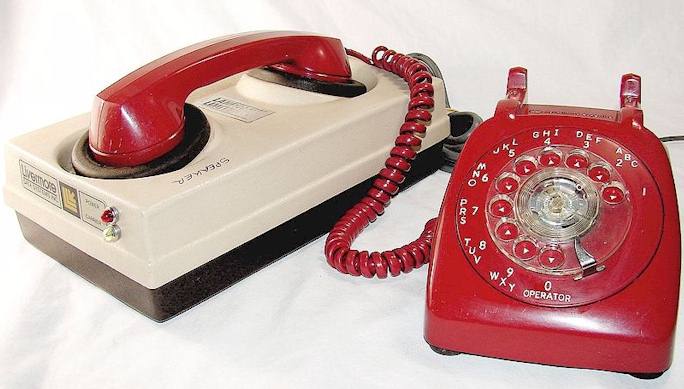
CHAPTER 8
ATTACHÉ CASE TELEPHONES
Note-See also the attaché phones listed in previous chapters, prior to 1974
The development of practical transistorized circuitry led to ever smaller designs, which required less power, thus the attaché case telephone became possible by the late 1960's. The attaché case telephone was very much a "James Bond" item offered initially in the late 1960's, despite being somewhat impractical. Some of the makers of attaché phones were Livermore Data Systems Corp. of Livermore, California (later Livermore Communications,) Canyon Communications of Newhall California, GCS (successor to Canyon,) S/C/M Melabs, International Systcoms of Canada and one or two others. Most of the attaché case telephones were MTS, although Livermore and Canyon offered full IMTS/MTS versions of advanced design by the mid or late 1970's. All attaché case phones were very heavy and offered limited battery life. They were actually a mobile unit with a large nicad battery, all crammed into an attaché case. The antenna was a foil strip glued behind the leather interior trim of the upper half of the case. Jacks were usually available for external antennas and power sources, and in the case of at least the Canyon and GCS equipment, the briefcase telephone could be put into a vehicle trunk and a regular under-dash IMTS or MTS control head used by plugging the case into an extension cable in the car trunk. Note that since California did not change over to IMTS until late 1982, the original MTS attaché phones were still usable through that date.
S/C/M Melabs ( Carryphone )
Melabs, a division of Smith Corona, the typewriter manufacturer, acquired an attaché phone design in 1967 from Carryphone Co. that appears to have been the first portable MTS car telephone. In 1966 Carryphone had contracted with Melabs to build the phone, called the Commander 701. It was then was unable to pay for the production of phones and evaporated, and the principal of Carryphone apparently took in money for franchises and then absconded, without paying the designers or Melabs. Melabs then attempted to sell them themselves with the Melabs labeling. Melabs' product was taken over later by Livermore Data (see Livermore Data information below.) The Melabs story is a bit strange, in that in late 1969, they hired a marketing agency to sell distributorships for this new attaché phone across the United States. The agency ran ads in the Wall Street Journal seeking investors, and at meetings in various cities, sold franchises at a price of approximately $ 25,000 - $ 50,000 depending upon the area. Evidently Melabs, and certainly the "investors," were unaware that there were no new customer number assignments available from the AT&T operating companies themselves in most urban areas and some entire states. In other words, the phone customers would be buying a $ 2500 portable telephone which was unusable as no numbers were available. At least one investor who bought a franchise in Indiana sued Melabs in federal court, although unsuccessfully. The text of that decision is available on-line.
It may have been the case that AT&T was holding small banks of numbers for its own leased-phone customers while not making any available for "number assignment only" outside ones , since in 1972 the typical phone lease, using a California example, cost $ 85 per month plus air time charges.
I have been told that there was some sort of lawsuit involving AT&T as well, and by 1970 Melabs had sold the design with some tooling and inventory to Livermore Data Corporation after making less than 1000 phones. The physical appearance of the Melabs phone is very similar to the Livermore version and identical to the Carryphone item other than the nameplate. Melabs seems to have also produced a mobile version as well, which was the predecessor of the Livermore Data models, but information is lacking on this point. Melabs attaché phones are surprisingly common today despite the small number produced, perhaps because few people would throw away something they paid $ 2500 for, even though it had become useless.
CLICK HERE For a copy of the S/C/M Melabs Attaché Phone Ad
LIVERMORE COMMUNICATIONS
The Livermore Data briefcase telephones were of much better quality than the Canyon products (below) but are otherwise unremarkable, except that most of them when found today, other than having dead batteries, would still work. The Livermore sets were initially MTS only in operation (LAP-1000 ?), but at least one full IMTS/MTS version was made (LAP-2000.) Livermore purchased the attaché phone assets from S/C/M Melabs, one of the first manufacturers of an attaché phone. Apparently the original attaché phone was called the "Carry Phone" and was designed by Melabs for S/C/M, however S/C/M Melabs was involved in assorted litigation with investors and (apparently) AT&T. Melabs abandoned the project after manufacturing somewhat less than 1000 phones. Livermore Data Systems was also engaged in manufacturing acoustic computer modems and early computer items. It later changed its name to Livermore Communications when the data division was sold. Livermore Communications went out of business in the early 1980's. It is my understanding that one of the principals of the firm, Gilbert Margouth, was the mayor of Livermore, California and deputy California Superintendent of Schools at one time.
Both the Canyon and Livermore sets were high power units, approximately 20 watts, and battery life in IMTS operation was rather short.
One of Livermore's Telephone Modems:

LIVERMORE DATA LAP-2000 ATTACHÉ PHONE
The Livermore LAP-2000 was the IMTS improved version of the original S/C/M Melabs MTS attache phone (LAP-1000) which Livermore acquired the rights to produce from S/C/M (above.) Note the unusual hole in the panel where a switch can select 5 or 7 digit ANI's. Apparently this was to accommodate areas still using 5 digit MTS signaling but also allowing roaming into areas with 7 digit IMTS systems. This is the only phone I have ever seen with a customer accessible ANI switch. These phones were also available with a red handset and red lettering, so it's possible that there were other colors such as beige or white. This is a great phone and worked very well.
CANYON AND GCS ATTACHÉ PHONES
GCS MARK 1000 ATTACHÉ PHONE
Diagram courtesy of Jim P.
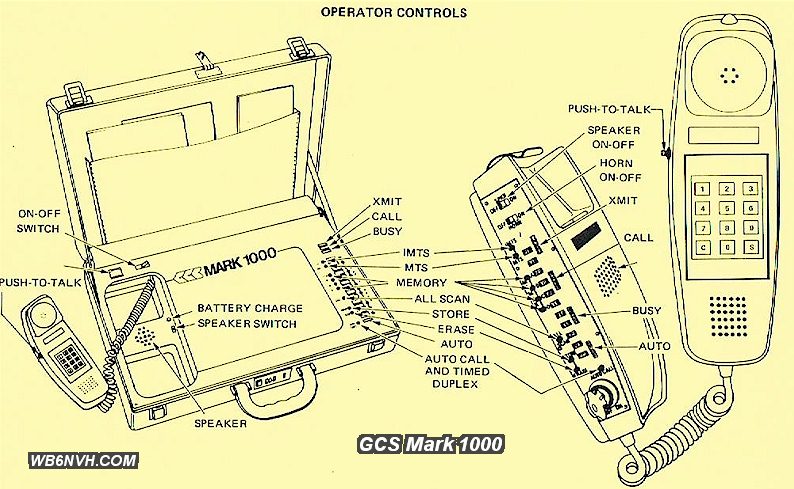
The first Canyon mobile and attaché case phones seem to have appeared in the early 1970's in response to the difficulty independent dealers had in obtaining Bell System format MTS phone equipment. They appear to have marketed their products essentially by word of mouth and direct cash payment although many were sold. There probably was an MTS only attaché phone as Canyon's first product, perhaps the Mark 800 (?) The Mark 900 dates from approximately 1976 and later.
In terns of the internal circuitry, the Canyon Mark 900 and prior telephones are the crudest in appearance and appear almost home-made. They are either MTS or IMTS and contain a duplexer and an early signaling logic board design. The first Canyon service manual is full of hand-drawn schematics and hand-written notes, as if the item was created in someone's garage (it may well have been.) They were obviously made in limited numbers and never benefited from the refinement of mass production. Construction and component quality are poor, and the circuitry amateurish in appearance. The pushbuttons are a cheap and terribly unreliable design. The later (after about 1977) IMTS Canyon briefcase telephones feature supervisory selectors supplied by Uniden of Japan. Canyon was sold to Pace about 1980, which in turn rather quickly sold it to two investors who continued the company as GCS, with a facility near the John Wayne Airport in Orange County, California. GCS stood for General Communication Systems. GCS later moved the production facility to Glendale, closer to the homes of the principals. GCS introduced considerable improvements to the equipment and corrected many things, and continued to market an improved version of the Mark 900 briefcase phone as well as one called the Mark 1000, but was out of business by 1984 due to competition from cellular equipment in the marketing target areas. See advertisement below. Canyon made the Mark 700, 800, 900 series phones, while the very late 900, and all 1000 series were by GCS. Details of the 700 and 800 are unknown; they may have been for RCC (Radio Common Carrier) non-Bell systems. I have been unable to find any advertising for Canyon, in contrast to the professional-appearing material for GCS. GCS was owned by two principals from La Canada Flintridge, California.
Canyon MK900 IMTS:
GCS Mark 1000 - difference between this and Mark 900 is unknown, other than pushbutton handset on 1000:
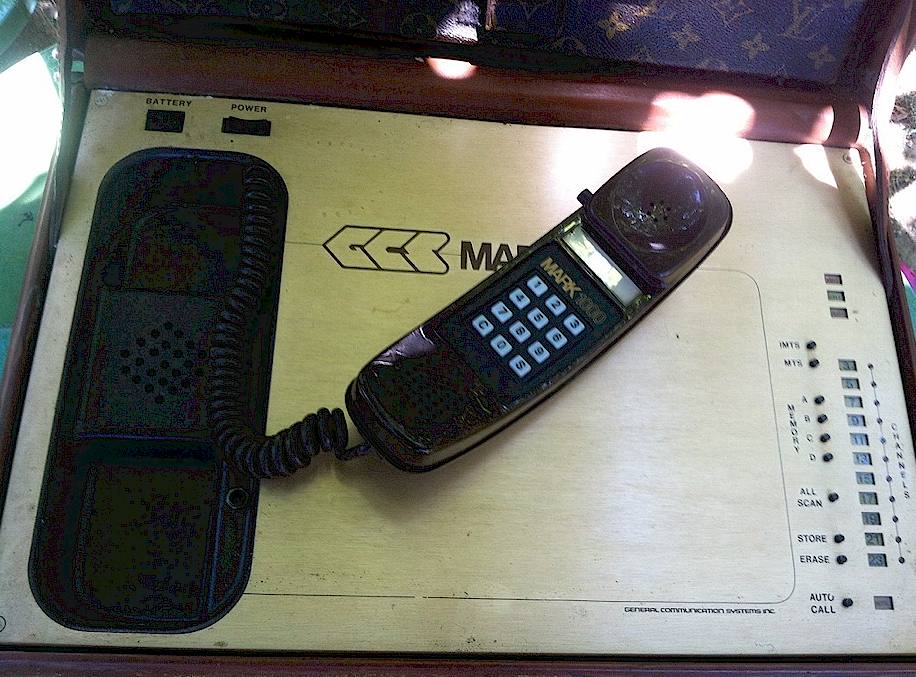
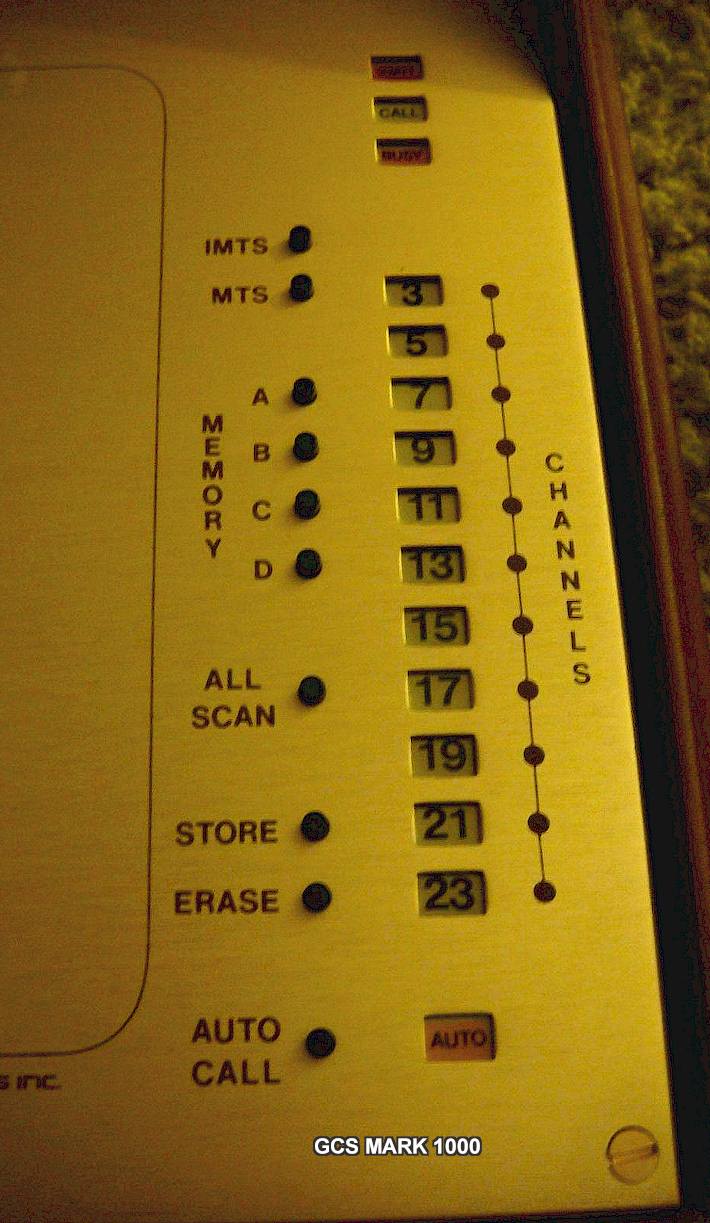
TO SEE MORE GCS LITERATURE, CLICK HERE
Car Mount Kit:
The Canyon Mark 900 and 1000 were also available as a conventional mobile telephones (shown some paragraphs above under Canyon heading,) and this attaché case could also be placed in the vehicle's trunk and connected to a cable set, which would bring in an external antenna line and a control cable from the car's interior, where a separate control head would be mounted. In other words, it became a conventional mobile telephone while driving, but when the driver left the car, he could remove the attaché case from the trunk and take the telephone with him. There was a dummy plug which had to be replaced in the connector at the bottom of the attaché phone to return it to normal operation. This was the only attaché phone brand I am aware of to offer such a feature.
Note that in order for the Mark 900 and 1000 phones to function normally, a special shorting plug was required which would be inserted in this socket located on the bottom of the attaché case, which is otherwise used to connect the permanently mounted handset assembly in the front of a vehicle with this case mounted in the trunk. It's missing in this example. The small earphone-like jack is for the external antenna.
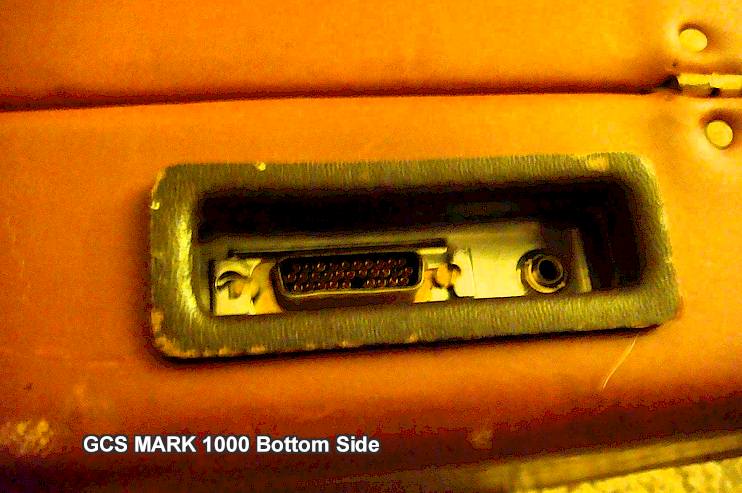
The design of the Mark 900 began in 1970 and underwent a number of minor changes to the RF section and major revisions to the logic section during its lifespan. It was also sold as the Skytronics Travtel in the early years of production. Most of its production seems to have occurred in the mid and late 1970's, hence its placement in this section of the page.
The Mark 900 head, used solely as the attaché case extension, and not on the mobile radio also curiously called Mark 900, is shown below. For some reason the actual permanently-installed mobile telephone, shown elsewhere on this site, did not use this head and required the customer to supply one which contained signaling logic.
The lettering on the illuminated lenses was rather crude and poorly applied, and has flaked off over the years.
A final version of the Mark 900 control head, by GCS:
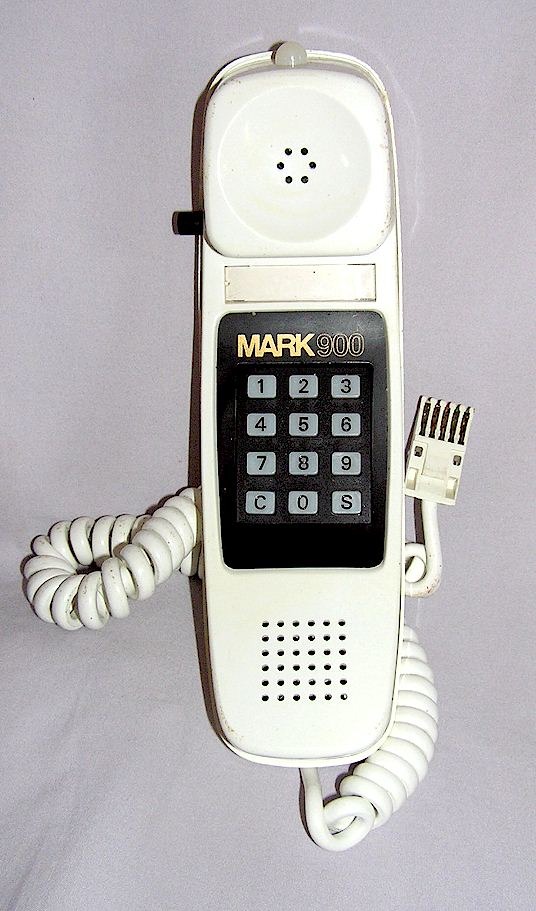
TEL-COM 150A:
The Tel-Com 150 was manufactured in Garland, Texas by Integrated Systems Technology. The 150A was manufactured in the early 1970's and about 2100 were made, at a retail price of $ 3500. Appearance is quite similar to the Canyon MK900 shown above. It is unknown whether any other Tel-Com attaché phone models were made. Tel-Com sold a number of these phones to celebrities of the era and wealthy oil men, but otherwise, they are somewhat obscure. IST also manufactured a companion mobile telephone, and an accessory generic IMTS control head.
Photo courtesy Ron Smith
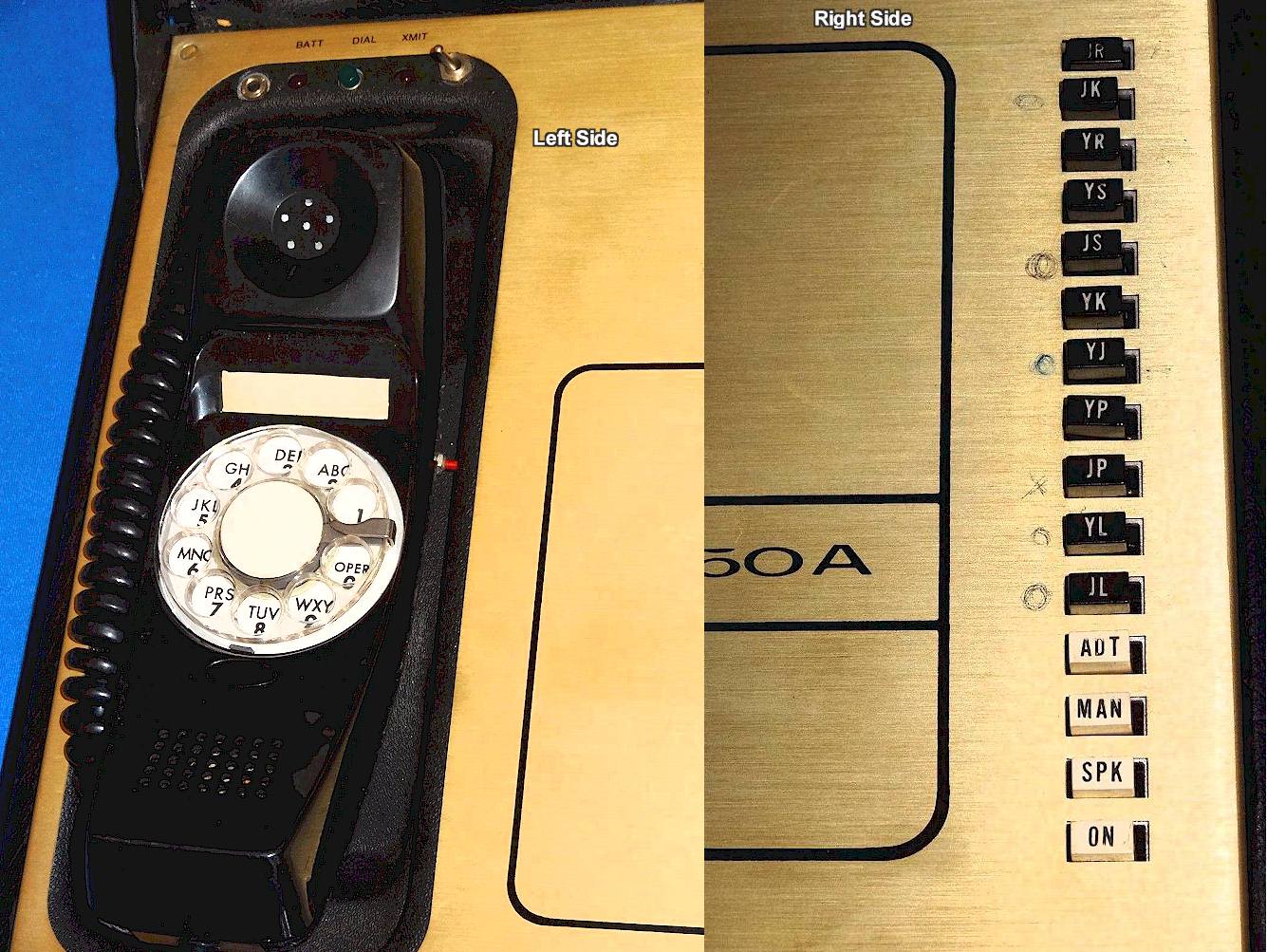
TRIGILD:
A rather obscure attaché phone from Ontario, Canada is the Trigild as shown below. It covers 13 VHF channels, the Canadian scheme, and is somewhat crude in presentation and appears to have not been marketed much in the USA, if at all. Trigild made several Gemini Series attaché phones as well as a Galaxy Series (see below.)
It is not clear if any of these were actually full-duplex or IMTS. The brochures speak of "all 13 MTS channels." The later series phones offered 24 channels, for use in the Alberta, Canada mobile telephone system, which was somewhat different from IMTS or MTS, and seems to have been a "marked idle" MTS system. As far as dates, the Gemini System 4 probably dates from the early 1980's.
Photo courtesy of Wikipedia
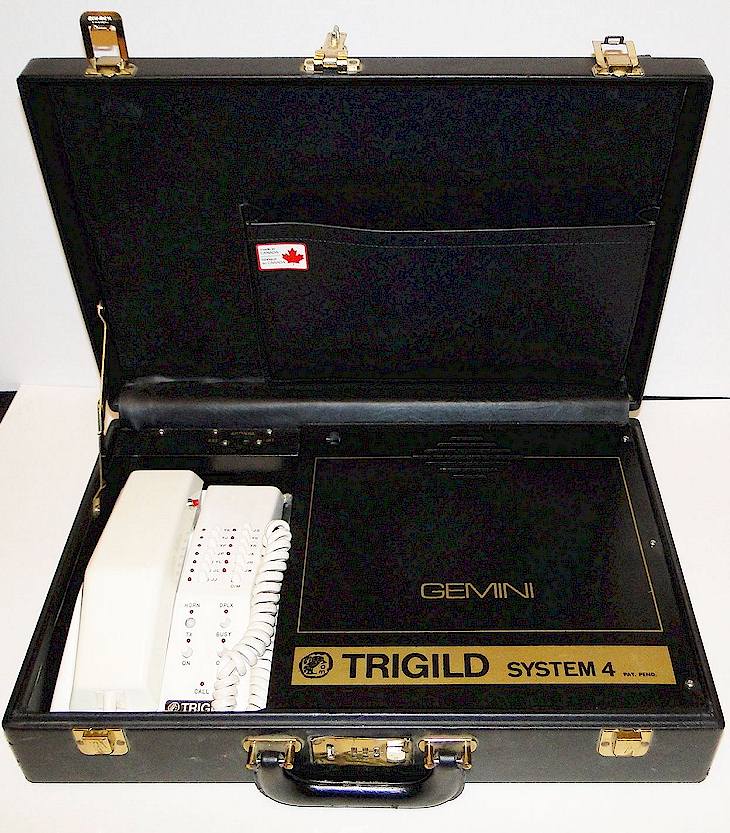
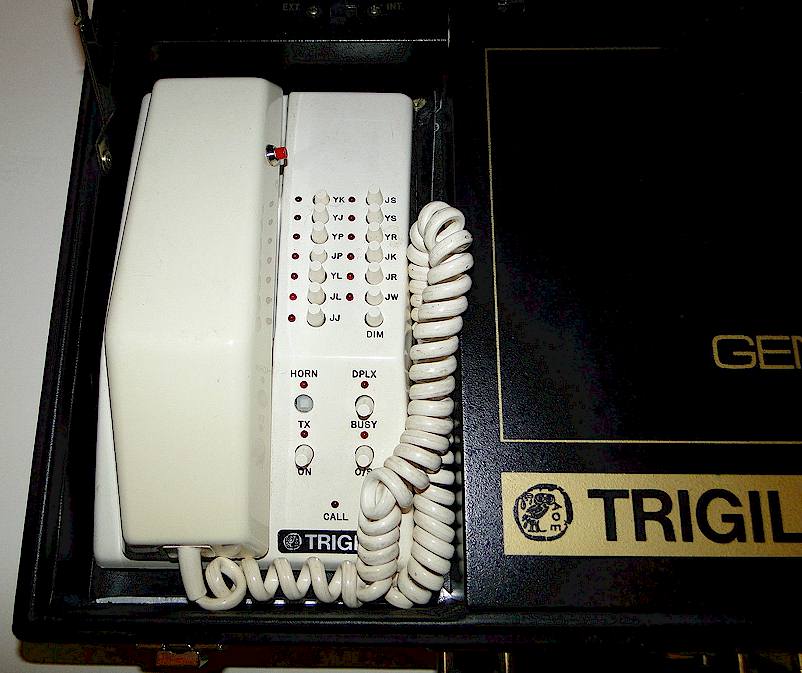
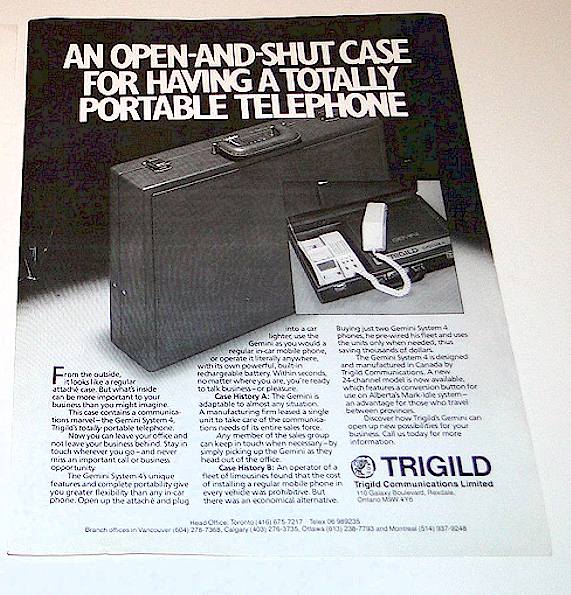
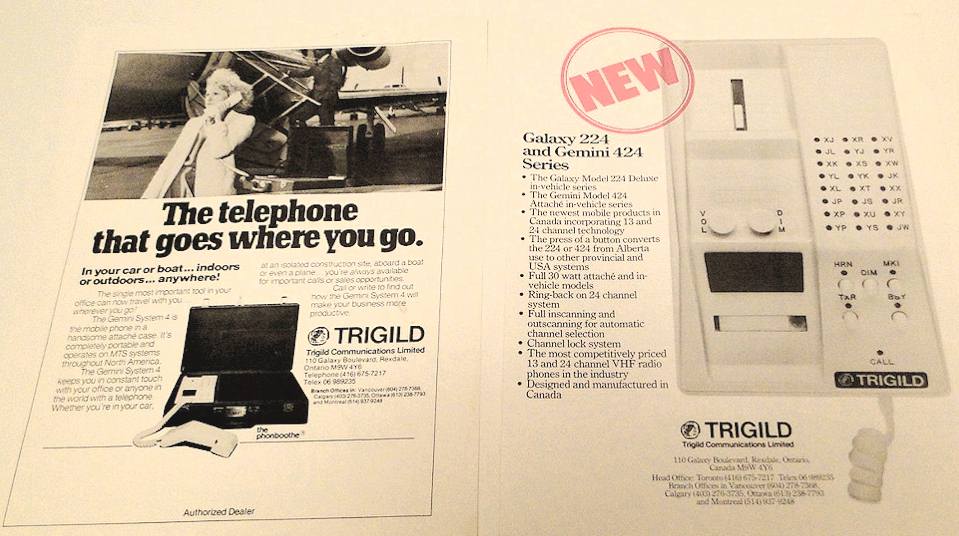
EXECUTIVE:
A rather obscure attaché phone called the Executive was advertised briefly in the 1970's. Apparently there was an optional installed control head allowing the attaché case to be connected and left in the trunk, as with the Canyon MK900 above. However, note that this phone was not IMTS. and as can be seen, is a generic mobile radio stuffed into an attaché case. It appears there was a duplexer available if desired.
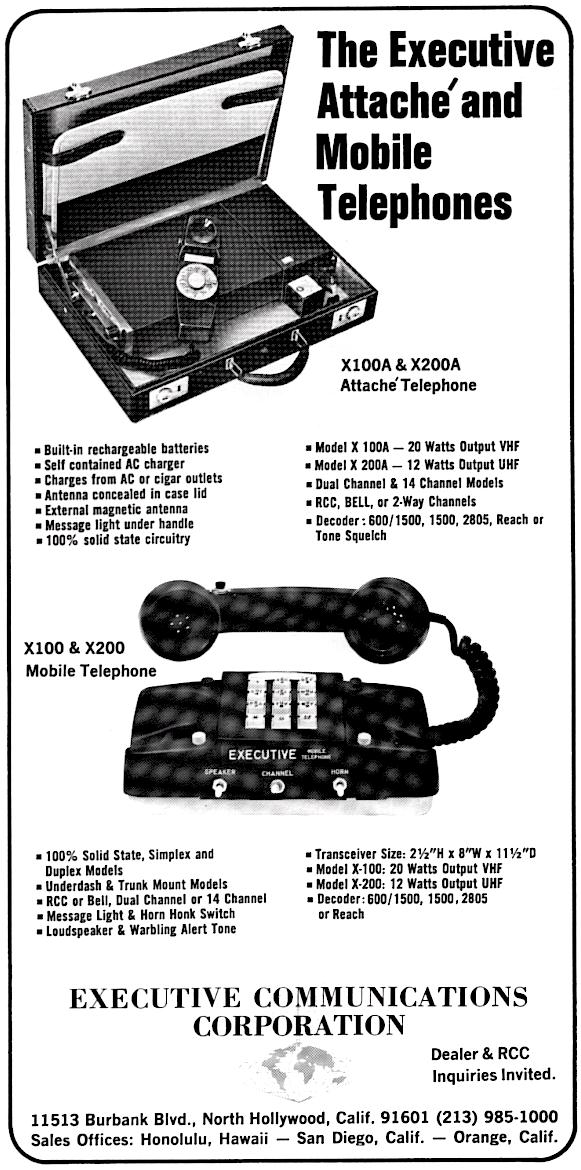
Ver. 10/19/2014 ©Geoffrey C. Fors 2007 All rights reserved